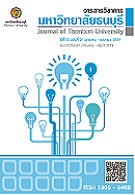การพัฒนารูปแบบการประเมินสภาพแวดล้อมภายในเพื่อพัฒนาองค์การธุรกิจนำเที่ยว
Main Article Content
Abstract
การวิจัยนี้เป็นการวิจัยเชิงสำรวจโดยใช้เทคนิคแบบผสมผสานระหว่างวิธีวิจัยเชิงคุณภาพและเชิงปริมาณ มี วัตถุประสงค์เพื่อ (1) ศึกษาปัจจัยที่ใช้ในการประเมินสภาพแวดล้อมภายในเพื่อพัฒนาองค์การธุรกิจนำเที่ยว และ ( 2) พัฒนารูปแบบการประเมินสภาพแวดล้อมภายในเพื่อพัฒนาองค์การ การศึกษาเชิงคุณภาพกระทำโดยการสัมภาษณ์เชิงลึก ผู้เชี่ยวชาญด้านองค์กรธุรกิจนำเที่ยว เพื่อสำรวจตัวแปรที่เป็นองค์ประกอบของรูปแบบการพัฒนา นำผลสำรวจนี้ไปสร้าง แบบสอบถาม เพื่อไปสำรวจความคิดเห็นของผู้บริหารองค์การธุรกิจนำเที่ยวที่จดทะเบียนบริการนำเที่ยว ในกรุงเทพมหานครจำนวน 220 ตัวอย่าง ตัวแปรอิสระที่ใช้ในการศึกษาประกอบด้วย การบริหาร ผู้บริหาร การจัดการ ทรัพยากร ลูกค้า การนำเที่ยว และการประเมินผลและการควบคุม ตัวแปรตามในการศึกษาประกอบด้วย รูปแบบประเมิน สภาพแวดล้อมภายในเพื่อพัฒนาองค์การธุรกิจนำเที่ยว สถิติที่ใช้วิเคราะห์ข้อมูล ใช้สถิติเชิงพรรณนา (Descriptive Statistics) ประกอบด้วย ค่าร้อยละ ค่าเฉลี่ย และสถิติเชิง องค์ประกอบเชิงยืนยัน (Confirmatory Factors Analysis)
ผลการวิจัยพบว่า
1) ผู้บริหารองค์การธุรกิจนำเที่ยว ส่วนใหญ่เป็นเพศหญิง อายุส่วนใหญ่อยู่ในช่วง 36 ปีขึ้นไป การศึกษาอยู่ระดับปริญญาตรี จัดตั้งองค์การธุรกิจนำเที่ยวมากกว่า 7 ปีขึ้นไป
2) การพัฒนารูปแบบการประเมินสภาพแวดล้อมภายในเพื่อพัฒนาองค์การธุรกิจนำเที่ยว พบว่า ด้านการบริหารเชิงอนุมาน (Inferential Statistics) ประกอบด้วย การวิเคราะห์ จะต้องมีการกำหนดนโยบายขององค์การที่ชัดเจน ด้านผู้บริหารต้องเป็นแบบอย่างที่ดี ด้านการจัดการทรัพยากรต้องให้ ความสำคัญผู้นำเที่ยว ต้องพัฒนาผู้นำเที่ยวให้มีความรู้ ความสามารถในการนำเที่ยว และมีบุคลิกภาพที่ดี ด้านลูกค้าต้องมี การสื่อสารกับลูกค้า โดยเน้นการโฆษณา ด้านการนำเที่ยวจะต้องเสาะหา/การสร้างเส้นทางนำเที่ยวใหม่ ๆ และด้านการ ประเมินผลและการควบคุมโดยการทบทวนผลการปฏิบัติงานที่ผ่านมา
3) การวิเคราะห์องค์ประกอบเชิงยืนยันของการพัฒนารูปแบบการประเมินสภาพแวดล้อมภายในเพื่อพัฒนา องค์การธุรกิจนำเที่ยว พบว่า ปัจจัยด้านการบริหารมีค่าน้ำหนักองค์ประกอบมากที่สุดคือการให้รางวัลแก่ผู้ทำตนเป็นแบบอย่างขององค์การ รองลงมาได้แก่ด้านผู้บริหาร โดยผู้บริหารต้องใช้การสื่อสารและการจูงใจ ความเป็นผู้นำในการ บริหารองค์การให้มีประสิทธิภาพ ด้านการจัดการทรัพยากรให้ความสำคัญกับการเงิน กำลังคนและสิ่งอำนวยความสะดวก ด้านลูกค้าให้ความสำคัญกับการโฆษณา ด้านการนำเที่ยวให้ความสำคัญกับการปรับปรุงเส้นทางเที่ยว และด้านการ ประเมินผลและการควบคุมให้ความสำคัญกับการสำรวจความพึงพอใจของลูกค้า โมเดลสมการโครงสร้างของการวิเคราะห์ องค์ประกอบของการพัฒนารูปแบบการประเมินสภาพแวดล้อมภายในเพื่อพัฒนาองค์การธุรกิจนำเที่ยวมีความสอดคล้อง กับข้อมูลเชิงประจักษ์ในเกณฑ์ดีโดยมีค่า P-value =0.065, χ2 = 1952.85, df = 1381.00, χ2 /df = 1.41, RMSEA = 0.062, CFI = 0.98 และ TLI = 0.99
A MODEL DEVELOPMENT ON INTERNAL ENVIRONMENTAL ASSESSMENT FOR TRAVEL BUSSINESS ORGANIZATION
This research employs integrative approaches of qualitative and quantitative methods to 1) study factors that are used in assessing internal environments of tourism organizations and 2) develop approaches to assess internal environments of tourism organizations. The outcome from both objectives is for promoting organizational development. The qualitative research is carried out through in-depth interviews of 220 tourism business experts using questionnaires verified with respect to validity and reliability. Independent variables consist of administration, administrators, resource management, tour leaders, customers, evaluations and control while a dependent variable is an approach used for assessing the organizations’ internal environments. Descriptive statistics used in analyzing data include calculations of percentages and averages while inferential statistics used is a confirmatory factor analysis.
The findings are listed below:
1) The majority of administrators of tourism organizations are females; the common age is greater than 36 years old; and they operate the tourism business for more than seven years.
2) Regarding the assessment on the internal environments of the organizations in various aspects, it is necessary to set priorities as the followings: 2.1) for the administration, the organizational policies should be explicit; 2.2) for the administrators, they should be distinct role models; 2.3) for the resource management, the capacity building for tour leaders is essential including promoting personality development, 2.4) for customers, boosting communication with customers through advertisement should be carried out; 2.5) for tour leading, seeking out new routes to market is recommended; and 2.6) for evaluation and control, there should be reviews of previous works on a regular basis.
3) The confirmatory factor analysis of this study reveals that a factor with the greatest weighing is rewarding employees on good performance (in administration category); followed by using communication and persuasion strategies and effective leading ship (administrator category); prioritizing management of amenities, financial and human resources (resource management category); promoting advertisement (customer category); improving touring routes (in tour leading category); and surveying customers’ satisfactions (evaluation and control category). An equation model of the confirmatory factor analysis of this study corresponds to the empirical data with the p-value of 0.065, x2 = 1952.85, df = 1381.00, x2 /df = 1.41, RMSEA = 0.062, CFI = 0.98 and TLI = 0.99.

